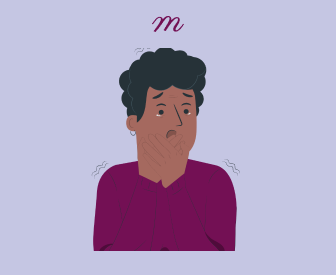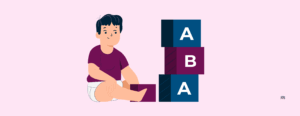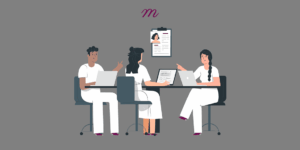What's a panic disorder?
Panic disorder is a psychiatric condition that affects approximately 4.7% of U.S. adults at some point in their lifetimes (NIMH, 2023). Panic disorder often starts in the teens or early adulthood, and it is twice as common in women than in men (NIMH, 2023).
This condition is characterized by unexpected and repeated episodes of intense fear accompanied by physical symptoms, along with anxiety about experiencing recurrent attacks. A panic attack involves a sudden surge of profound fear or discomfort, coupled with a minimum of four of the following symptoms:
Accelerated heart rate or palpitations
Sweating
Trembling or shaking
Shortness of breath
Feeling “smothered”
Feelings of choking or throat tightness
Chest discomfort or pain
Abdominal distress or Nausea
Dizziness, light-headedness, or faintness
Heat flashes or Chills
Sensations of Numbness or Tingling
Feelings of unreality (derealization) or being detached or “out of body” (depersonalization)
Sense of impending doom
Anxiety about "losing one's mind" or losing control
Dread of death
The sudden and intense onset of fear or discomfort reaches a peak within minutes
Panic attacks are relatively common, with approximately 11% of people in the United States experiencing a panic attack each year (NIMH, 2023).
Experiencing panic attacks doesn't automatically indicate panic disorder. For a panic disorder diagnosis, the individual must also endure at least one of the following symptoms for a month or more:
Persistent worry about having another panic attack or the possible consequences of another panic attack (such as losing control).
Changes in behavior related to panic attacks (such as avoiding certain situations because they might trigger an attack).
Panic disorder, which ranges from mild to severe, is diagnosed when at least some of the panic attacks are unexpected, so if an individual only has panic attacks in specific situations, panic disorder would not be diagnosed. A large number of individuals with panic disorder also experience additional psychiatric disorders, such as agoraphobia, various other anxiety disorders, and depression, which are the most frequent ones.
ICD-10 Overview
The International Classification of Diseases, 10th Edition (ICD-10), is a globally recognized system for classifying and coding diseases, mental health conditions, disorders, and other health-related conditions. It serves as a universal language for healthcare professionals, allowing for standardized documentation, billing, and statistical analysis of health data (ICD-10, 2004).
ICD-10 Code: F41.0 – Panic Disorder Without Agoraphobia
F41.0 is part of the larger F41 category, which includes anxiety disorders. Specifically, F41.0 refers to panic disorder without agoraphobia. Agoraphobia involves anxiety about being in places or situations where escape might be difficult or embarrassing or where help is unavailable. This code is used to classify instances of recurrent, unexpected panic attacks that are not accompanied by a specific fear of being in places or situations where escape might be difficult.
To assign the code F41.0 accurately, clinicians should adhere to the diagnostic criteria outlined in standard psychiatric references such as the Diagnostic and Statistical Manual of Mental Disorders (DSM-5-TR). Mental health professionals should carefully assess and document these features.
Mental health professionals should regularly update their knowledge of the ICD-10 system and ensure accurate coding to enhance the quality of care provided to individuals experiencing panic attacks and related disorders.
Differential Diagnosis
Accurate diagnosis requires differentiation from other anxiety disorders, medical conditions (such as cardiovascular or respiratory issues), and substance-induced anxiety. Thorough evaluation and collaboration among mental health professionals is essential.
Exclude panic disorder with agoraphobia (F40.01)
Exclude anxiety in:
acute stress reaction (F43.0)
transient adjustment reaction (F43.2)
neurasthenia (F48.8)
psychophysiological disorders (F45.-)
separation anxiety (F93.0)
Mental health professionals should adhere to ICD-10 coding guidelines, ensuring specificity and completeness in coding practices. Regular updates on coding changes and guidelines are imperative for accurate coding.
Treatment Strategies
The primary approach to treating panic attacks is psychotherapy, with cognitive-behavioral therapy (CBT) being one of the most effective modalities. CBT focuses on identifying and changing negative thought patterns and behaviors that contribute to panic attacks. CBT often includes exposure therapy, which involves gradually and safely exposing individuals to the physical sensations associated with panic attacks to reduce fear and anxiety.
Medications can play a role in the treatment of panic attacks, particularly in cases of severe symptoms or when psychotherapy alone is insufficient. Selective serotonin reuptake inhibitors (SSRIs) are commonly prescribed as a first-line pharmacological treatment. These medications, such as fluoxetine, sertraline, or paroxetine, increase the levels of serotonin in the brain, which helps regulate mood and reduces the frequency and intensity of panic attacks. SSRIs are preferred over other antidepressants due to the low incidence of side effects in many patients (Garakani, et. al., 2020).
Sometimes benzodiazepines, such as alprazolam or clonazepam, may be considered for short-term relief of acute symptoms. Benzodiazepines can provide immediate relief from panic attacks. They are generally prescribed with caution due to the risk of dependence and withdrawal symptoms upon discontinuation.
Treatment depends on individual preference, treatment goals, severity of symptoms, and response to treatment. Many clinicians combine psychotherapy and medication for optimal results. Regular monitoring and follow-up are essential to assess treatment progress, adjust interventions, and address any emerging issues.
Ongoing support from mental health professionals, as well as psychoeducation about panic attacks, can empower clients to manage their symptoms effectively and improve their overall quality of life.
Adjusting treatment plans may involve modifying the type or dosage of medication, refining psychotherapeutic techniques, or exploring alternative therapeutic modalities. Periodic evaluations ensure the chosen interventions remain appropriate and effective for the individual's evolving needs.
While panic disorder may be a chronic condition, appropriate and individualized treatment plans, including psychotherapy, medication, and ongoing monitoring, can lead to significant improvement in symptoms and the reduction of panic attacks over time. This comprehensive approach helps to manage acute episodes.
Importance of Documentation
Accurate and detailed documentation in the mental health field serves many critical purposes, spanning accurate ICD-10 coding, billing, continuity of care, treatment planning, communication among team members, and compliance with regulatory requirements. Accurate recording of client information allows mental health professionals to deliver high-quality and comprehensive care.
Coding and Billing.
Using the correct ICD-10 code ensures that mental health professionals are appropriately reimbursed for their services. Clear documentation allows for the translation of medical services into standardized codes, facilitating the billing process and reducing the risk of claim denials or delays.
Continuity of Care.
Thorough and complete documentation provides a detailed account of a client's history, current status, and progression over time. This perspective is vital for ensuring continuity of care as different mental health providers, specialists, or facilities become involved in the client's treatment. It allows for a seamless transition of information, enabling each clinician to make informed decisions based on the client's complete mental health history.
Complete and accurate documentation is the foundation for effective treatment plans. Mental health professionals can then make informed decisions about the most appropriate and personalized course of action. Treatment plans are the roadmap for ongoing mental health care and aid in the coordination of multidisciplinary treatment approaches.
Communication Among Team Members.
Accurate documentation fosters effective communication among members of the mental health team, including physicians, nurses, therapists, and administrative staff. Detailed client records enable seamless collaboration, ensuring that everyone involved in the client's care is well-informed about the current status, interventions, and upcoming plans. This collaboration is vital for providing holistic and coordinated care.
Compliance with Regulatory Requirements.
Mental health providers must adhere to various regulatory standards and legal requirements. Accurate ICD-10 coding and detailed documentation ensure compliance with these standards, safeguarding client privacy and confidentiality while also meeting reporting and documentation requirements. Failure to maintain accurate records can lead to legal and ethical challenges.
Quality Improvement and Research.
Data from accurate and thorough documentation contributes to quality improvement initiatives and research initiatives. Researchers and mental health institutions can use this data to identify trends, assess the effectiveness of treatments, and implement evidence-based practices to enhance overall client care.
Conclusion
Understanding ICD-10 code F41.0 for panic disorder without agoraphobia holds significant importance for mental health professionals for these reasons:
Accurate Diagnosis. Making a precise diagnosis allows clinicians to distinguish panic attacks from other anxiety disorders or phobias that might have similar symptoms but different treatment approaches. Mental health professionals must identify and differentiate panic disorder without agoraphobia from other conditions to provide targeted interventions.
Tailored Treatment Planning. Once an accurate diagnosis is achieved, mental health professionals can create personalized treatment plans. Therapeutic interventions, including cognitive-behavioral therapy (CBT), medication management, or a combination, can be appropriately tailored to treat panic attacks. Each treatment option has its own set of benefits and potential side effects, and an accurate diagnosis helps the clinician select the most effective and suitable approach for individual clients.
Enhanced Client Care. Precise ICD-10 coding facilitates better communication among mental health professionals involved in the client's care, ensuring everyone involved—psychiatrists, psychologists, social workers, primary care physicians, psychotherapists, and others—have a clear understanding of the client's diagnosis and prognosis. Clarity improves collaboration and allows for a cohesive approach to managing the client's condition, resulting in improved outcomes.
Insurance and Reimbursement. Proper coding using the ICD-10 facilitates accurate billing and insurance claims, ensuring mental health professionals can appropriately document and bill for the services provided. This reduces errors or delays in reimbursement processes. Proper coding also helps to justify the necessity of certain treatments or interventions to insurance companies.
Research and Data Analysis. Accurate ICD-10 coding assists researchers in compiling reliable data for research purposes. It contributes to epidemiological studies, treatment outcome research, and understanding the prevalence and patterns of panic attacks. This information is vital for developing better interventions and improving mental health policies.
Understanding and utilizing the ICD-10 code F41.0 is essential for mental health professionals as it enables accurate diagnosis, tailored treatment, improved client care, and streamlined administrative processes.
References:
Garakani A., Murrough J., Freire R., Thom R., Larkin K., Buono F., Iosifescu D. (2020). Pharmacotherapy of Anxiety Disorders: Current and Emerging Treatment Options. Frontline of Psychiatry, 11:595584.
International Classification of Diseases, Tenth Revision (ICD-10). Retrieved from: https://www.cdc.gov/nchs/icd/icd10.htm
National Institute of Mental Health (2023). Panic disorder. Retrieved from: https://www.nimh.nih.gov/health/statistics/panic-disorder
Why other mental health professionals love Mentalyc

“A lot of my clients love the functionality where I can send them a summary of what we addressed during the session, and they find it very helpful and enlightening.”
Therapist

“Having Mentalyc take away some of the work from me has allowed me to be more present when I’m in session with clients … it took a lot of pressure off.”
LPC

“It takes me less than 5 minutes to complete notes … it’s a huge time saver, a huge stress reliever.”
Licensed Marriage and Family Therapist

“By the end of the day, usually by the end of the session, I have my documentation done. I have a thorough, comprehensive note … It’s just saving me hours every week.”
CDCII







